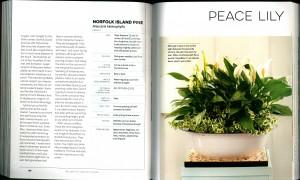Posted by Beth on Saturday, Feb 20, 2016
Winters are long in Iowa. By the time the middle of February comes around, Mother Nature begins to tease us with bright sunny days. But look at a calendar and you'll see that we are still more than a month away from Spring.
If you're itching to get your hands in the garden there is something you can do now that might make it feel like spring - get a new houseplant! Tovah Martin's new book "The Indestructible Houseplant - 200 beautiful plants that everyone can grow is "for all the windowsill-gardener wannabes... For all the folks who hankered for houseplants but didn't know where to start, and for all the people who picked up the wrong houseplant and thought its hasty demise was their fault, this book is for you."
The Idestructible Houseplant is both a good reference book and a fun read. (Yes, books can be both.) If you're looking for a book on houseplants and you want to look up just one plant, hit the index in the back and it will tell you where to turn. Or hit the table of contents for her list of 200 plants and go from there.
But if you're looking for a fun read, start at the very beginning. Tovah Martin is an entertaining writer. Her snappy style and entertaining storytelling will get you hooked. She'll tell you the story of how she got hooked on houseplants, how the idea for this book came to be, what her home is like and how she tested plants to come up with her 200 surviving "indestructibles."
The 200+ page "Gallery of Indestructibles" lists her choices in alphabetical order. Each new plant begins with an entertaining page or more describing the plant, a beautiful color photograph, and half-page table listing the plants features: it's common name(s), Latin name, a rating (easy or easiest), size range, foliage description, other attributes, desired light exposure, water requirements, optimum night time temperature, rate or growth, soil type, fertilizing, issues and ideal companions.

The last 40 pages take you through what she calls "The Details" - choosing a plant; general cautions about plant toxicity; light, humidity and temperature considerations; choosing and preparing a container. The list of sources are mainly in Connecticut, but all have websites.
There is one thing I was surprised by. The groupings called "Ferns" and "Ivy" are examples of when the author groups plants into a family. The information is general rather than specific to any of the individual types found in the index. Not that the information isn't good, but it might not be appropriate to ALL the different plants in either family.
This is a great gardening book, and I'm definitely adding it to my wish-list.


Not really an introduction to growing cactus and succulents as much as a home reference guide, this wonderful book can keep you entertained for hours learning about choosing and caring for both indoor and outdoor succulents -Beth